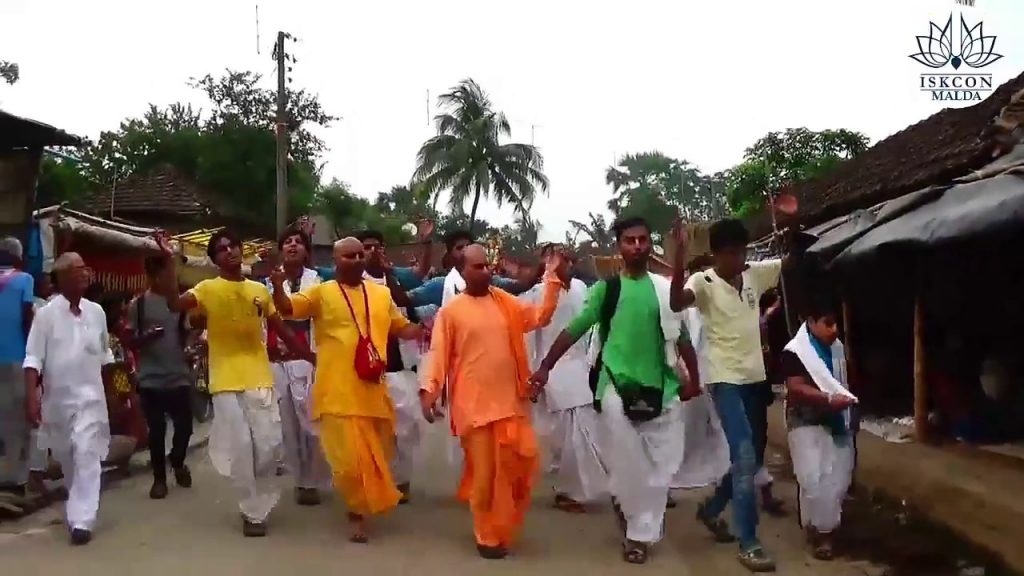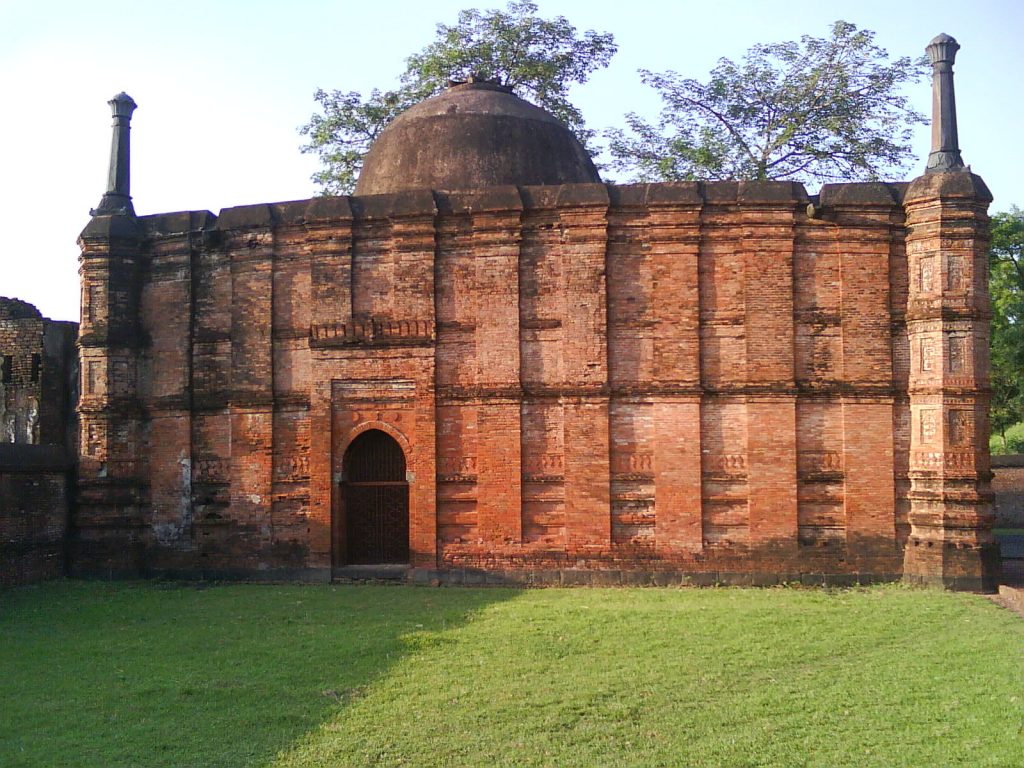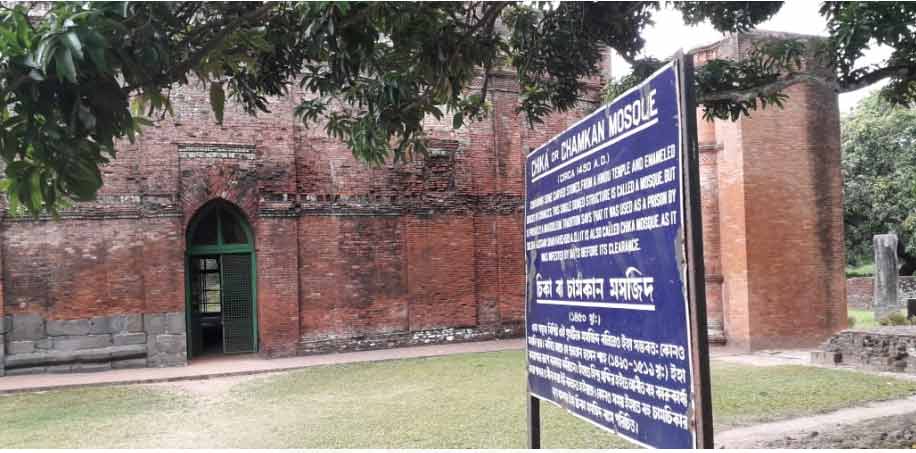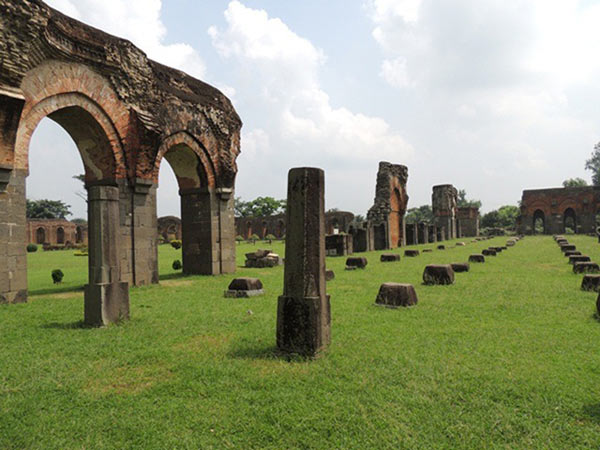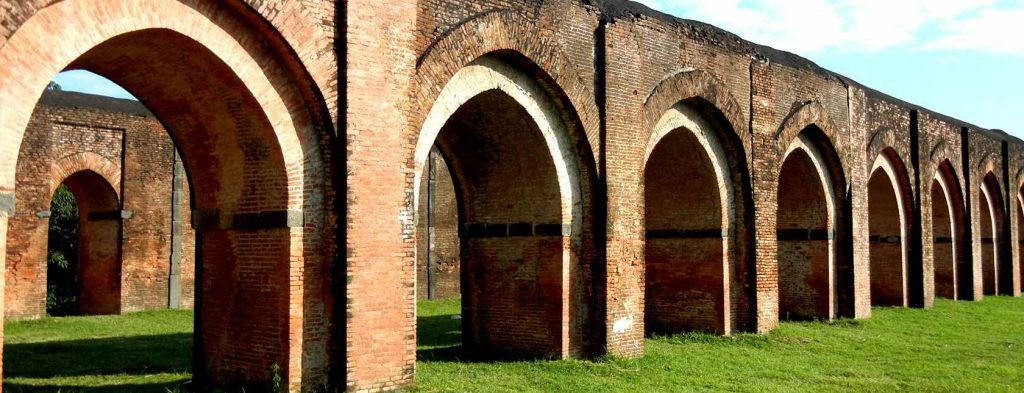
Malda: Maldah district (Malda or Maldaha) is a district of West Bengal, India. Malda Town is situated nearly 347 kilometers (215 miles) north of Kolkata and is 6 – 7 hours drive. The latitude range is 24°40’20″ N to 25°32’08″ N, and the longitude range is 87°45’50″ E to 88°28’10″ E. Jute, Mango and silk are notable products of this district. The special variety of mango produced in this region, popularly known by the name of the district, is exported across the world and is acclaimed internationally. The folk culture of Gombhira is a feature of the district, being a unique way of representation of joy and sorrow of daily life of the common people, as well as the unique medium of presentation on national and international matters. Malda town is situated in the Malda district of the state of West Bengal. It is also known as English Bazaar. The place was established as a municipality during the 19th century and there are a few historical places that can be seen in the town. Mango trade and silk manufacture are the main economic activities. The Independence Day of Malda is 17 August 1947.
History of Malda : The glorious past of Malda is associated with the ruined city of Gaur and Pandua. Gaur is historically a very important place as a large portion of Bengal’s ancient history was written here. Malda also houses a great conglomeration of ancient mosques which reminds of the Mohammedan rulers who reigned here for centuries.
The ancient city of Gaur in Malda has also been mentioned in Hindu Puranic texts and its history is recorded since 500 B C. During those days Gaur and Pundrabardhana (Pandua) was under the Mauryan Empire. Archeological findings have also indicated that the whole of North Bengal was part of the Gupta Empire in those ancient times. Thereafter, the Guptas were succeeded by the king of Karnasubarna in 700 A.D, who ruled for almost thirty years. From mid 8th century to 11th century AD the Pala dynasty ruled Bengal and promoted Buddhism in the region actively. After the rule of the Palas it was the turn of the Sen Dynasty; Balal Sen was the third ruler of the Sen Dynasty who ruled over Gaur and established sole control over entire Bengal within 1168 A.D. The Sen Dynasty wielded their rule over Bengal till 1204 AD, after which, the Mughals and Afghans ended their rule by invading Bengal.
Influence of the Afghan and Mughals throughout Malda in the form of beautiful mosques, among which, most of them lay in ruins today and is looked after by the Archeological Society of India (ASI). History states that Malda was conquered by the Mughals in 1198 A.D. and was the headquarters during their rule in Bengal. After the Afghans came to power, the headquarters were relocated to Pandua and they left a scene of plunder in Gaur. But Pandua was deserted in 1453 and Gaur came to prominence again. In 1539, Gaur was attacked by Sher Shah, and in 1575 it was invaded by the army of Akbar. Curiously, after the occupation of the city by Akbar a severe plague hit and it was completely abandoned and the city was in a heap of ruins.
The soil of the district is particularly suited to the growth of mulberry and mango, for the production of both of which Malda has become famous. One Day Sightseeing in Malda includes the following sites
Ramkeli Mela: The 500-year-old famous Baishnab-fair ‘Ramkeli Mela’ commenced near Gour in Malda from 15th June, 2013. The Six (06) day fair has drawn scores of pilgrims and monks from across the country with several forms of rituals and devotional songs being performed. The fair has been organized to commemorate the arrival of Sri Chaitanya in this holy place on ‘Jaishtya Sankranti’ some 500 year ago. Temporary medical centers and arranged additional transports for smooth conduction of fair, attended by innumerable devotees. The officials have also tightened security. We hope that more tourists will join the Mela by popularizing the famous Baishnab fair. There were the representatives of ISCKON Mayapur with other cultural program all around the large area. Thousands of pilgrims joined the event. EHTTOA members also participated in the Mela.
The week-long fair (mela) took place around the last days of the Bengali lunar month of Jyaistha (usually the height of summer) in a small village right outside the still impressive ruined gates and walls of the ancient Bengal capital of Gaur. It is said that the great saint of Gaudiya Vaishnavism, Chaitanya Mahaprabhu (1486-1534), met and converted two of his principle disciples, the brothers Rup and Sanatan Goswami, who were important courtiers of the Muslim Sultan of Gaur, in Ramkeli. The Fair marks that occasion. It was a great gathering place for singers of the Bengali Kirtan style of Vaishnavite devotional music.
Still exist are the footprints of Sri Chaitanya Deva. Under the tree, where Sri Chaitanya Deva met with the brothers, two scholars of Sanskrit literature Roop and Sanatan Goswami, still exist. Ramkeli commemorate the visit of Sri Chaitanya Deva during the Ramkeli fair every year. During the fair, lakh of pilgrims came and gathered in tents, makeshift stays and hotels nearby, ignoring the hot Sun to memorize again the dignified presence of Sri Chaitanya Deva. Through Chaitanya Deva lifetime works to extricate the bitter feeling among different religions, he brought sweet memories of brotherhood. The temple complex where the great preacher once strolled made one feel his pious presence in the air and in the enchanting bells of the temple.
A small village on the way to Gour, Ramkeli is famous for being the temporary home of Sri Chaitanya, the great religious reformer of Bengal, where he had stayed for a few days on his way to Brindaban. A conglomeration of two tamal and two kadamba trees can still be seen, under which the saint is said to have meditated. A small temple constructed under this tree contains Sri Chaitanya’s footprints on stone. There are eight kundas or tanks flanking the temple. Every year, on the Jaishthya Sankranti, a weeklong celebration is held here to commemorate the arrival of Sri Chaitanya. This year it started from 15th June, 2013. This Mela was inaugurated by MIC Tourism with hundreds of pilgrims enjoying the same. The whole area was flooded with pilgrims at Gaur nearly 12 kilometers south of Malda; right on the Indo-Bangladesh border is a historical relic of 14th and 15th Century Bengal. Places of sightseeing are the Bara Sona Mosque, Dakhil Darwajah (built in 1425), Qadam Rasul Mosque, Lattan Mosque and the ruins of the extensive fortification. There are colourful enameled tiles on the Gomti Gate and Firoz Minar. Chinese traveller Hiu-en Tsang visited to have Buddhist lessons from here. The place houses the footprint of Prophet Muhammad, William Carey the prominent missionary Christian worked towards mankind. It was like rediscovering the united picture of India in diversity. It was greatly enticing experience to remember. Our journey began, for the concluding part of the Malda site seeing.
Places of Interest: The ruins, relics and monuments of bygone era when rulers with different origins, religions and motives ruled the land is still are important sites to visit. It is a feast for the insatiable senses of archeologists and curious tourists who are interested in ancient history of Bengal, and of India.
- Adina
- Gour (23 Kilometer for the whole circuit including Sagardighi, Orchard, Ponds, Temples, Mosque etc)
- Baroduari
- Dakshin Darwaza
- Firoz Minar
- Excavation site (Rajbari)
- Kadam Rasool (Grave of Fate shah / Foot print)
- Chika
- Gamti
- Lukuchuri Gate
- Chamkhati
- Tantipara
- Loton Mosque
- Kotowali Gate
- Gulmath
- Sagardighi
- Ramkheli Mandir (Baishnab Culture)
- Bangladesh Border
- Radha Raman Mandir (Baishnab Tirth)
- Giridhari Mandir
- Jagjibanpur
- Ganga Cruise (Hazarduari & Mayapur – Katua – Kalna- Sri Krishna Circuit)
- Pirhana Pir
- Jaharatala Temple
- Pandua Mosque (Jordan)
The rivers, ponds and other water bodies including marshy areas of Malda produce considerable quantities of various categories of fishes mention may be made Rohu, Katla, Chital, Boal , Magur, Shol, Hilisha, Pabda and varieties of Crabs , Prawns, Turtles etc. The town is also famous for its numerous plantations and these are worth visiting, if you are travelling to the region. The Raiganj Bird Sanctuary is also present in the district and this might be worth checking out. Many species of migratory birds can be seen in the place. Some activities that can be used in Malda are
- Cruise in Ganga
- Fishing
- Birding
- Visiting Mango Plantation & Camping
- Visiting Silk Rearing & Camping
The town also has a museum that houses a few old artifacts and also various archeological samples that have been found in the region, is a good place for history buffs to visit. There are a few ruins that are located in the region and the primary ones are Gaur and Pandua. The main historical site in the town of Malda is the Jama Majid that was built during the year 1566. The Nimsari Tower is also a popular place in Malda.
At Gour
Ramkeli – 14 kilometers south of Malda- contains footprints of Sri Chaitanya on stone
Bara Sona Masjid – Half a kilometer from Ramkeli, it is also called Baro Duari Masjid. It was, started by Allaudin Shah and completed by his son, Nasiruddin Nusrat Shah in 1526. The Indo-Arabic style of architecture and the ornamental stone carvings make Baroduari a special attraction for tourists
Dakhil Darwaza – Built in 1425 and also known as Salami Darwaza it was once the main entry for the fort. It is more than 21 meters high and 34.5 meters wide.
Feroze Minar – A kilometer away from Dakhil Darwaja, it was built by Sultan Saifuddin Feroze Shah during 1485 – 1489. 26 meters high and 19 meters in circumference, it resembles the Qutub Minar of Delhi
Chika Masjid – Sultan Yusuf Shah built the Chika Mosque in 1475. The beautifully ornate carvings on the walls and the images of Hindu idols on the stonework of doors and lintels are still partly visible
Kadam Rasul – Half a kilometer from the Feroze Minar, this mosque was built by Sultan Nasiruddin Nusrat Shah in 1530. It contains the footprints of Hazrat Muhammad on stone
Tomb of Fateh Khan – Opposite the Kadam Rasul Mosque this 17th century tomb of a commander of Aurangzeb’s army is an interesting structure, built in the Hindu chala style
Tantipara Masjid – A short distance away has intricate terracotta work
Lukochuri Darwaja – Located to the south-east of the Kadam Rasul Mosque, this is a place where the sultans played hide and seek with the begums. There is a difference of opinion as to who built this gate, some say that Shah Shuja built it in 1655, others opine that it was built by Allauddin Hussein Shah in 1522. The innovative architectural style makes it an interesting place to visit
At Pandua
Adina Masjid – This was built in 1369 by Sultan Sikander Shah it was one of the largest mosques in India. Carved basalt masonry from earlier Hindu temples is said to have also been used
Qutub Shahi Masjid – Also known as the Chhoto Sona Masjid, built to honour Saint Nur Qutb-ul-Alam. The ruins of his shrine are nearby, along with that of Saint Hazrat Shah Jalal Tabrizi, collectively known as the Bari Darga
Eklakhi Mausoleum – Eklakhi Mausoleum is the most elegant monument in Pandua, with a carved Ganesh on the doorway. It is a tomb of the son of a Hindu Raja, who converted to Islamic community
Activities – Various activities can be developed in Malda. Huge water bodies can have houseboats with all modern facilities and can be rightly used during the summer time as the weekend outings. Rest of the period of the year the climate will be pleasant to have the houseboat. A cruise planned along the Ganges to all the religious site downstream is also a feasible project that can be developed here. It will be one of its kinds in this part of the country. The route planned is Hazarduari & Mayapur – Katua – Kalna – Sri Krishna Circuit. The very next cruise is in Brahmaputra in Guwahati.
Maldah Museum – Stationed at Bandh road in Malda city, this museum preserves the architectural and anthropological samples of the region. Run by the West Bengal Directorate of Archaeology, the museum has been recently renovated. It showcases ancient sculptures, porcelains, calligraphic inscriptions and terracotta items as well as other artifacts which are almost 1500 years old, all belonging to nearby places like Pandura and Gaur. It is a worth visiting site while traveling to Malda city.
Art & Culture – Steeped into the charm of multi ethnicity the culture of Malda echoes the very spirit of the land. During the partition a bulk of immigrants arrived from East Pakistan and resided in the extensive areas of Malda including the outskirts. Dominated by the Bengali and the people of Bihar, prevalently, the district of Malda is also inhabited by the people belonging to the Muslim and Santali sects.
Like all other places of India there is something unique about Malda. Malda has nice cultural extravaganza like Gombhira, Alkap, Kabigan etc. The folk culture of Gambhira is a characteristic feature of Malda. It signifies the everyday life blended with joy and sorrow, which is the very spirit of the common life in Malda. Various national and international matters are also presented in a unique way though that folk drama. Gambhira is a type of song (originating in Chapai Nawabganj, in the Northern region of Bangladesh). It is performed with a particularly distinctive rhythm and dance with two performers, always personifying a man and his maternal grandfather, discussing a topic to raise social awareness. This kind of song is also quite popular in Malda of West Bengal, India.
Festivals
- Durga Puja
- Ramkeli Fair Gour
- Kartik Puja Fair
- Charu Babu Mela
- Charak Fair
- Piran-e-Pir fair
Light & Sound – A light and Sound Program can be developed here at Adina Mosque. The same model to be used in different parts of West Bengal like Adina Mosque, Cooch Behar Palace, Hazaar Duari, etc.
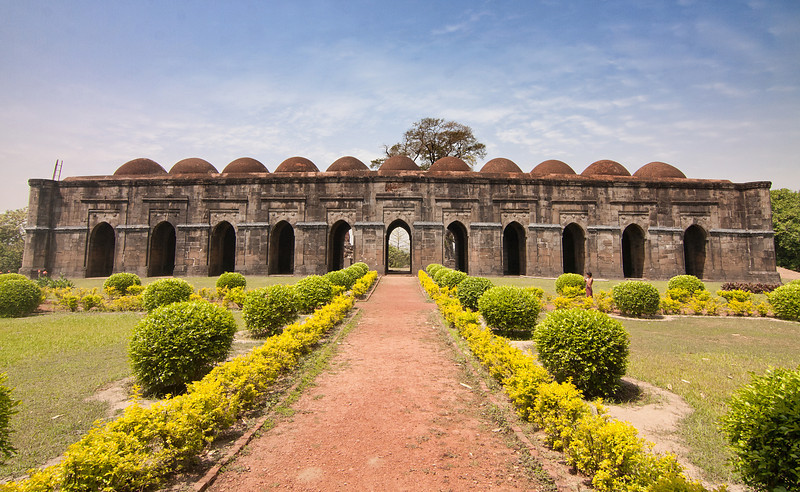
Contact: www.dreamwaydestinations.com & www.visittobengal.com Or Call me at +919733465000 & +919474092500 Or WhatsApp : +918617432205
